Toilet bowl device - how it works and what it consists of
Comfortable housing is simply unthinkable without a well-equipped toilet room, the central place of which is reserved for the toilet. An important element of this sanitary appliance is a drain tank, which is sometimes even hidden in the wall, however, when it goes down, its significance becomes clear. Next, we look at how the toilet bowl is arranged, which may be necessary to eliminate all kinds of faults.

The principle of the tank
The drainage system performs an extremely important function - it empties the toilet. Without it, this plumbing device would turn into a night vase, so it is the sink that ensures comfortable use of this plumbing fixture.
The workflow of the drain is quite simple:
- On a flexible hose, water from the water supply system enters a tank equipped with a filling and drain mechanism.. The filling mechanism closes the water when it is recruited to a certain level.
- When the button is pressed or the rod is raised, the drain valve is activated, as a result of which water from the tank enters the toilet and thus the contents are flushed out., which goes down the drain.

In general, the principle of operation of the drain is quite simple and consists in the alternate operation of the mechanisms located inside the tank, which are called shut-off valves. Next, we will try to examine in detail the locking device for the toilet cistern, to which we usually do not pay attention in everyday life.
Components of drain fittings
Knowing how the toilet cistern is designed, it will not be difficult to repair or replace the failed parts. Of course, the design of different models may differ, however, the basic elements and the principle of their operation are the same for all types of valves.
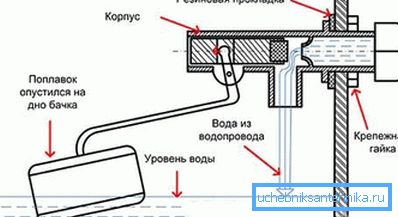
Filling mechanism
As mentioned above, the task of the filling mechanism is to provide access to water in the tank and its overlapping, when necessary. This mechanism consists of the following elements:
| Stop valve | Located in the case, located at the "entrance" to the tank. The task of the toilet cistern valve is to shut off the water. |
| Lever float | The task of the part is to regulate the position of the valve. When the float is lowered, the valve opens. When the float is at the top - the valve completely blocks the water. |
It must be said that modern shut-off valves look a bit different, in particular, the float moves only in the vertical plane, and the valve itself is located at the bottom, not at the side. However, the principle of the mechanism remains the same.
Such a toilet cistern device made it possible to ensure not a gradual overlap of water, but a complete one at the very end of the set. Due to this capacity is recruited much faster.
Note! For normal operation of the drain you need to adjust the position of the float. Otherwise, an insufficient amount of water will be drawn into the container, or vice versa, water through the drain will constantly drain into the toilet.
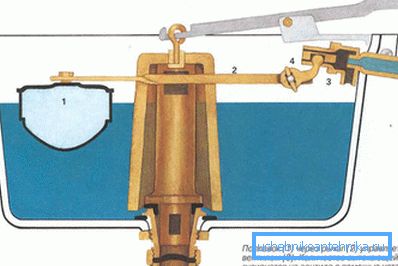
The mechanism of discharge and overflow
The simplest and first plum mechanism was a system with a pear. She worked extremely simply - there was a rubber bulb inside, hermetically blocking the drain hole. It was necessary to raise the lever or pull the handle on the chain, as the water rushed with a noise into the toilet.
The toilet bowl device has now changed. This reinforcement assembly consists of two main elements:
| Overflow | Prevents capacity overflow. If the water level reaches the maximum permissible level, water begins to flow into the toilet. |
| Plum | It starts functioning by pressing the button located on the tank lid. In modern models of the toilet there are two buttons - for partial and full drain, which saves water. |
Despite the more complex design, the principle of the work of the drain remained the same - the drain hole hermetically closes the drain valve, which is lifted when the button is pressed.

Tip! According to experts, German fittings are of the highest quality, however, its price is very high. If you do not have the opportunity to purchase German fittings, you can buy Polish, which also has good quality, but it costs much less.
It should be noted that according to the type of location of the tank there are two types:
- Suspended - in this case, the container with the toilet is connected by means of a pipe through which water flows.
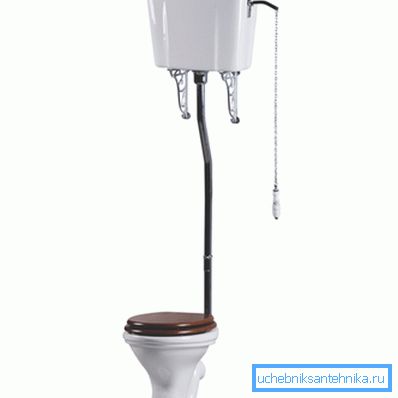
- Installed on the shelf of the toilet - in this case, the drain hole of the container is directly aligned with the hole in the toilet. For tightness of connection of pipes the rubber sealant is used.
- Mounted to the wall - in contrast to the two options described above, this capacity is installed in the wall. According to the principle of connection with the toilet, the design resembles hanging tanks.
Now that you know how the toilet cistern works, you can find the cause of the device malfunction and fix it yourself.
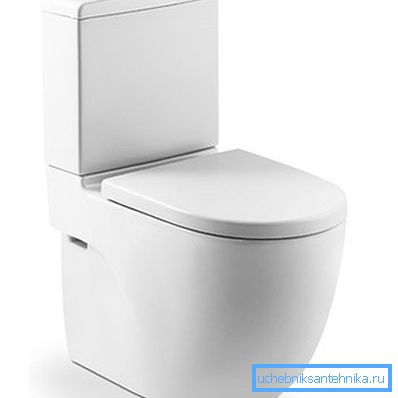
Tank classification
As mentioned above, different models of tanks may have some structural differences. Therefore further we will get acquainted with the most widespread their types.
Cans are classified into several groups.
First of all, conditionally they can be divided according to the location of the tank or button:
- Side - as a rule, it is used for hanging tanks for the toilet, which are located at a certain height. In this case, to drain the water, you have to pull the chain. The drain device, as a rule, is implemented in the form of a raised pear.
- Top - button or lever located on top, in the center of the cover. Armature drain in these tanks more complex.
In addition, containers differ in the material from which they are made.
Currently, the following types of products are found:
- Porcelain - the most expensive models are made of this material, therefore they are relatively rare.
- Earthenware - currently the most common option. They are mounted on the shelf of the toilet. Tanks from faience can have a very different design.
- Plastic - these containers are embedded in the wall and have a flat shape. Outwardly, they differ from traditional cisterns, as they resemble more a canister, however, the principle of their work is the same. In addition, there are suspended plastic tanks of the Soviet sample, lately they are becoming increasingly rare.
It should be noted that in some apartments you can even see cast-iron tanks, which are already a rarity.

The most common problems
Since the device of the toilet cistern is quite simple, regardless of the type of construction, there are not so many options for breakdowns. Next, consider some of them that are most often found:
| The tank does not hold water, as a result of which water constantly flows down the toilet. | There are several reasons for this trouble:
|
| Water flows from under the tank | This problem occurs in devices that are installed on the toilet. In this case, it is necessary to dismantle the container and replace all rubber seals, including gum fasteners. |
| Mechanical breakage of fittings parts | In this case, the only way out is to dismantle the defective part and go with it to a specialized store to purchase the same one. |
Note! Before you start repairing the tank, you will have to remove the cover with your own hands. This work must be done carefully so as not to break this part.
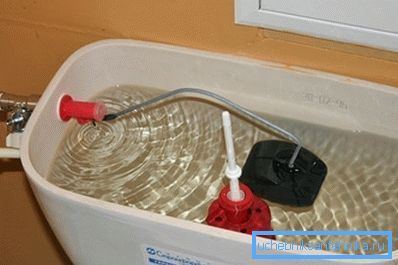
Here, in fact, all possible faults. Instructions for their removal is extremely simple, so every home craftsman will be able to cope with it.
Conclusion
Despite the fact that modern drain tanks have become much more perfect, their device still remains quite simple. Therefore, it is not difficult to understand the principles of operation of mechanisms and, if necessary, to repair them.
From the video in this article, you can learn some additional information on this topic.